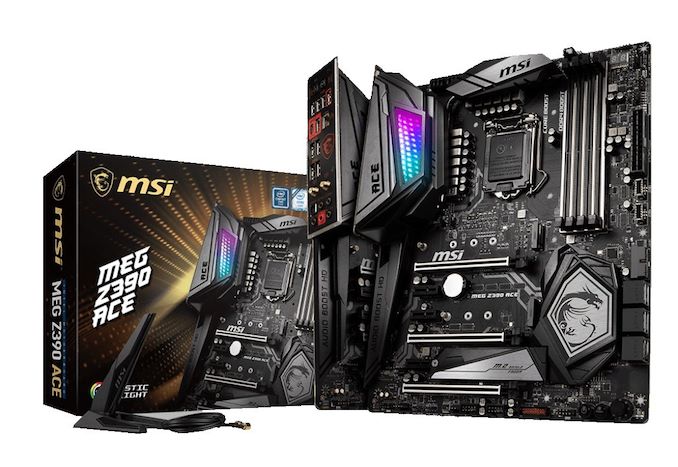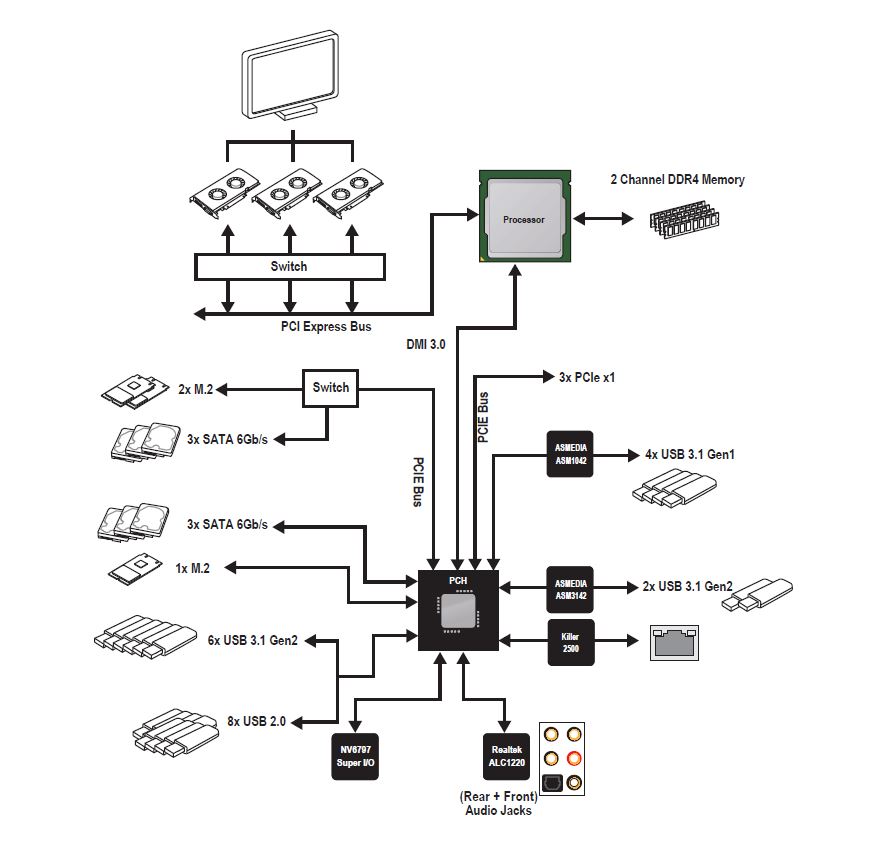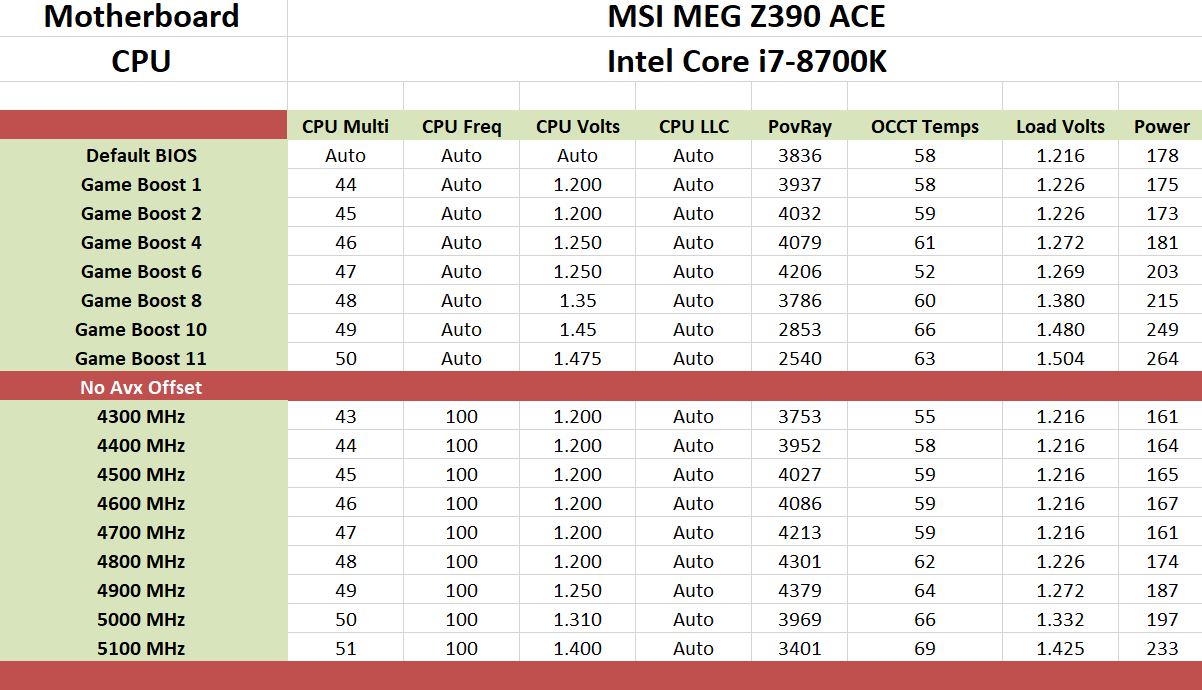The MSI MEG Z390 ACE Motherboard Review: The Answer To Your USB 3.1 Needs
by Gavin Bonshor on December 17, 2018 12:30 PM EST- Posted in
- Motherboards
- Intel
- Killer
- MSI
- Coffee Lake
- i7-8700K
- Z390
- ACE
- Z390 ACE

The MSI Z390 ACE sits below the MSI Z390 Godlike in the company's product stack and has plenty to shout about including a trio of M.2 slots, a well built power delivery, and as many USB 3.1 Gen 2 ports as you could ever need.
AnandTech 9th Gen CPU and Z390 Motherboard Coverage
- The Intel 9th Gen Review: Core i9-9900K, Core i7-9700K and Core i5-9600K Tested
- The ASRock Z390 Taichi Review: Jack of All Trades, Master of None
- Intel to Support 128GB of DDR4 on Core 9th Gen Desktop Processors
- Intel Z390 Motherboard Overview: 50+ Motherboards Analyzed
- GSkill Announces DDR4-4800 and DDR4-4500 Kits for Z390 Boards
The MSI MEG Z390 ACE Overview
The MSI Z390 ACE motherboard is aimed at gamers who are looking for premium features to create the foundations for a high-powered gaming system. In this case, MEG stands for 'MSI Enthusiast Gaming', which makes the first MSI redundant, and ACE doesn't stand for anything here, but MSI likes to make their brand names in ALL CAPS just like the GODLIKE so they pop out of the page when people scroll through the product list at Amazon or Newegg. Someone at MSI has put the marketing and naming into 'OVERDRIVE' (please don't make an all-caps motherboard called overdrive, please).
This model comes from MSI's premium product line, the Enthusiast Gaming range, and commands the weighty MSRP of $290. For that amount of money, MSI has to offer something special. The MSI Z390 ACE's core feature set includes four RAM slots with support for DDR4-4500 memory, three M.2 slots, six SATA ports, upgraded audio, a gaming focused 'Killer' network port, and the latest Intel Wi-Fi connectivity. On the design front, the Z390 ACE has a matte black PCB with a set of contrasting gunmetal grey heatsinks and a matching rear panel cover. The rear panel cover features an MSI Mystic Light Infinity panel which has a variety of customizable colors and effects which can be controlled by the MSI Mystic Light RGB software.
A quick glance at the specifications shows that the MSI Z390 ACE is a sub-set of the halo top-end MEG Z390 Godlike and is reflected in both the size and the in the price differences. The MSI Z390 ACE makes use of a Realtek ALC1220 HD audio codec and in keeping things consistent with a gaming flavor, MSI has also opted to use a Killer based E2500 Gigabit gaming LAN controller. In addition to this is the inclusion of an Intel 9560 802.11ac MU-MIMO Wave2 capable adapter which affords users both Wi-Fi and Bluetooth 5.0 connectivity.
Block diagram of the MSI Z390 ACE motherboard
On the technical front, MSI is advertising the Z390 ACE to contain a 13-phase power delivery. The heatsink attached itself has plenty of weight to it. The VCore/CPU section is running twelve ON Semiconductor high-side and low-side MOSFETs. This is controlled by an International Rectifier IR35201 PWM controller which is an 8-channel controller operating at 6+2. Each of the VCore phases features six individual doublers meaning the Z390 ACE is running a 6-phase design on the VCore. Providing power to the CPU is two 8-pin 12 V ATX power inputs while a standard 24-pin 12 V ATX input is there for to power the rest of the motherboards components.
With a total of three full-length PCIe 3.0 slots present, it is possible to run three-way CrossFire multi-graphics card setups on the Z390 ACE, but due to bandwidth limitations, a maximum of two NVIDIA cards in SLI can be accommodated. At the bottom right-hand of the PCB is an overclockers toolkit too. Cooling support is provided by seven 4-pin fan headers. USB 3.1 Gen2 ports are found on the rear panel, both Type-A and Type-C.
Looking at the performance of the MSI MEG Z390 ACE, nothing stands out as exemplary, although the most notable positives came in our 7-Zip encoding test and currently sits at the top of this benchmark. Another positive result came in our 3D Particle Movement and in POV-Ray, with comparable performance to other Z390 chipset boards on other tests. For system related tests such as POST time, the Z390 ACE sits middle of the road with a respectable time of just over 19 seconds; this was improved upon with controllers turned off in the BIOS by around 1 and a half seconds. Performance in other system-specific tests such as DPC Latency also sat middle of the road. The only real negative in our testing was in power consumption, which we explain in the review.
On the overclocking side of things, the MSI Z390 ACE performed well with manual overclocking, but ludicrous towards the upper end of the Game Boost profiles. As shown manually, we hit 5.0 GHz in our testing. There is plenty of headroom available for users looking to push their 8th and 9th generation processors beyond 5.0 GHz on this board, but the biggest factor in achieving this is keeping core temperatures as low as possible. Users with a 9900K might see better performance with the default solder-based thermal interface material.
The MSI Z390 ACE is one of two enthusiast specific MEG Z390 models which are aimed at the more premium end of the market. The other model in question is the MSI MEG Z390 Golike ($600) which sits right at the top of MSI's Z390 product stack for a sizable price. The Z390 ACE bridges the gap between the Z390 Godlike and the MPG Z390 Gaming Pro Carbon AC ($230) with a solid set of features. With a recommended retail price of $290, and the combination of specifications and aesthetics, MSI looks to woo users across multiple market areas.
Pages In This Review
- Overview [this page]
- Visual Inspection: Analysis of the Board Components
- BIOS and Software: Looking that the non-hardware portion
- Board Features and Test Bed: The full specification list, and how we test
- System Performance: Component testing, such as power, boot times, and DPC Latency
- CPU Performance
- Gaming Performance
- Conclusion














25 Comments
View All Comments
Byte - Thursday, December 20, 2018 - link
Wondering if the ESS Sabre really does anything to help the sound quality. Might get a MEG once they get cheaper just to try it.Orange_Swan - Sunday, January 13, 2019 - link
why does every motherboard HAVE to have that stupid PS/2 port, especially on mITX motherboards, where you could have an extra pair of USB sockets.rickybobby3 - Thursday, November 7, 2019 - link
i have the z390 ace and i purchase the h100i platinum cooler. it has a 3 pin plug for the header. but this board has 4 pin headers on the board? i have seen several people say this cooler is compatible with this board how are they pluging the 3 pin into the 4 pin fan header?empleat - Wednesday, January 6, 2021 - link
Thank you for posting DPC latency tests! Buying motherboard is shot in the dark. There are so many features, some differ per hardware and can cause huge input lag! From motherboard to motherboard: it is crazy how much mouse movement differs! Also some 500$+ ASUS mobos suffer from high DPC latency! So you can buy even highly rated mobos, which cost 500$ and then still get piece of garbage. Also there is 8k polling mouse now, which most of motherboards can't even handle. And 500hz monitors in 1-2 years. Also timer resolution supports only 0.5ms max. interval.I wish you would test even most infamous BIOS features, which cause input lag. But that's perhaps to much to ask. You would have to test literally every BIOS feature, which could, but doesn't have to lag... Also some can differ per hw configurations so...
Thank you for bringing attention to this! And for testing! You are MVP!